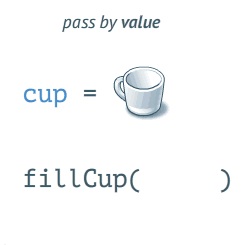Solidity 是一种面向对象的高级编译编程语言,用于编写智能合约,以及在不同的区块链上构建和部署 Dapp。
Solidity 与任何其他编程语言一样,有自己的数据类型和数据结构,但具有不同的语法和应用程序。
本教程将介绍 Solidity 编程语言中一些最常用的数据类型和数据结构。
Solidity 数据类型的性质
Solidity 本质上是一种静态类型的强类型语言,它在执行源代码之前执行类型检查。
作为一种静态类型语言,Solidity 要求程序员在编译代码(编译时)之前声明每个变量的数据类型。
而 Solidity 作为一种强类型语言意味着变量的数据类型不能在程序中修改或转换为另一种数据类型。
Solidity 数据类型
Solidity 和其他编程语言一样,将其数据类型分为两类:值类型和引用类型。
Solidity 中的值类型
值类型变量是将数据直接存储在分配给自身的堆栈内存中的变量。
这些类型是按值传递的,这意味着只要将它们分配给新变量或作为参数提供给函数,它们就会被复制,对新副本所做的任何更改都不会影响原始数据。
![https://hicoldcat.oss-cn-hangzhou.aliyuncs.com/img/V8P0OvCtl.gif https://hicoldcat.oss-cn-hangzhou.aliyuncs.com/img/V8P0OvCtl.gif]()
1.) 整数
Solidity 中的整数数据类型用于存储整数值。整数类型进一步分为int和uint用于分别声明有符号和无符号整数类型。
i. int/有符号整数
int关键字用于声明有符号整数。有符号整数是一种数据类型,可以在智能合约中保存正整数和负整数值。
1
2
3
4
5
6
7
|
// SPDX-License-Identifier: MIT
pragma solidity ^ 0.8.13;
contract Signed_Integer_Example{
int year = 2022; // positive value (✅)
int temperature = -89; // negative value (✅)
}
|
ii. uint/无符号整数
该uint关键字用于声明无符号整数。无符号整数是智能合约中只能保存正整数值的数据类型。
1
2
3
4
5
6
7
|
// SPDX-License-Identifier: MIT
pragma solidity ^ 0.8.13;
contract Unsigned_Integer_Example{
uint year = 2022; // positive value (✅)
uint temperature = -89; // negative value (❌)
}
|
当您尝试将负值分配给无符号数据类型时,您将收到以下TypeError消息:
1
|
TypeError: Type int_const -89 is not implicitly convertible to expected type uint256. Cannot implicitly convert signed literal to an unsigned type.
|
2.) 字节
Solidity 中的字节是包含字节序列的固定大小的字节数组。字节数组的长度在字节的前面定义,如bytes1to bytes32。
该数字相当于字节数组变量可以包含的字符数。
1
2
3
4
5
6
7
8
9
10
11
|
// SPDX-License-Identifier: MIT
pragma solidity ^ 0.8.13;
contract Bytes_Array_Example{
bytes1 one_character = "a"; // 1 character (✅)
bytes2 two_characters = "ab"; // 2 characters (✅)
bytes3 three_characters = "abc"; // 3 characters (✅)
bytes4 four_characters = "abcd"; // 4 characters (✅)
bytes5 five_characters = "abcde"; // 5 characters (✅)
bytes32 thrity_two_characters = "abcdefghijklmnopqrstuvwxyz123456"; // 32 characters (✅)
}
|
当您尝试分配超过固定字节大小的字符数时,如下所示:
1
2
3
4
5
6
7
|
// SPDX-License-Identifier: MIT
pragma solidity ^ 0.8.13;
contract Bytes_Array_Example{
bytes1 one_character = "ab"; // single value (❌)
bytes1 two_characters = "abc"; // single value (❌)
}
|
您将收到以下TypeError消息:
1
|
TypeError: Type literal_string "abc" is not implicitly convertible to expected type bytes1. Literal is larger than the type.
|
3.) 布尔值
Solidity 中的布尔值由bool关键字表示,并且与其他所有编程语言一样,Solidity 中的布尔值仅接受两个值:true和false:
1
2
3
4
5
6
7
8
9
10
|
// SPDX-License-Identifier: MIT
pragma solidity ^ 0.8.13;
contract Boolean_Example{
bool isEthereumMerge = true; // (✅)
bool currentUserCanMintToken = false; // (✅)
bool isRaining = "true"; // (❌)
bool isAdmin = "false"; // (❌)
}
|
当您尝试将非布尔值分配给布尔变量时,您将收到以下TypeError消息:
1
|
TypeError: Type literal_string "true" is not implicitly convertible to the expected type bool.
|
4.) 地址
地址是 Solidity 中的一种特殊数据类型,能够接收和发送 Ether。地址数据类型旨在存储以太坊地址,该地址通常以0x值开头。
地址大小为 20 个字节,包含 42 个字符。
1
|
0x0000000000000000000000000000000000000000
|
地址也是从公钥的Keccak-256 散列生成的不区分大小写的十六进制数字。
当您尝试将字符串分配给地址数据类型时,如下所示:
1
2
3
4
5
6
7
|
// SPDX-License-Identifier: MIT
pragma solidity ^ 0.8.13;
contract Address_Example{
address user_address = 0x0000000000000000000000000000000000000000; // (✅)
address user_home_address = "Street 2, downtown road"; // (❌)
}
|
您将收到以下TypeError消息:
1
|
TypeError: Type literal_string "Street 2, downtown road" is not implicitly convertible to expected type address.
|
当您尝试将非十六进制数字分配给地址数据类型时,如下所示的八进制数字:
1
2
3
4
5
6
7
|
// SPDX-License-Identifier: MIT
pragma solidity ^ 0.8.13;
contract Address_Example{
address user_address = 0x0000000000000000000000000000000000000000; // (✅)
address phone_address = 080123456789; // (❌)
}
|
您将收到以下ParserError消息:
1
|
ParserError: Octal numbers not allowed.
|
地址值类型进一步分为两种:
| 功能 |
address |
address payable |
| 检查地址余额 |
✅ |
✅ |
| 发送以太币 |
❌ |
✅ |
| 接收以太币 |
❌ |
✅ |
**专业提示:**当您希望您的智能合约接收和发送以太币时,请使用address payable值类型。当您不希望您的智能合约接收或转移以太币时,请使用纯address值类型。
5.) 枚举
枚举数据类型,也称为枚举,使开发人员能够创建用户定义的数据类型。用户定义的数据是分配给从零开始的整数常量值的名称。
1
2
3
4
5
6
7
8
9
10
11
12
13
14
15
16
|
// SPDX-License-Identifier: MIT
pragma solidity ^ 0.8.13;
contract Enum_Example{
enum Status {
Sending, // 0
Success, // 1
Failed // 2
}
Status status;
function sendSomething () public {
status = Status.Sending; // set status to sending
}
}
|
从上面的代码片段中,我们创建了一个Status枚举来保存我们发送内容时的操作状态。然后,我们可以使用枚举将操作的状态更新为枚举中的任何预定义状态Status。
Solidity 中的引用类型(数据结构)
引用类型变量是将数据的位置(内存地址)存储在堆内存上的变量,它们不直接共享数据。
对参考数据所做的更改将始终影响原始数据。
![https://hicoldcat.oss-cn-hangzhou.aliyuncs.com/img/56kIHvRbD.gif https://hicoldcat.oss-cn-hangzhou.aliyuncs.com/img/56kIHvRbD.gif]()
Solidity 中引用类型的示例包括字符串、结构、数组和映射。
1.) 字符串
string类型是一个字符序列。Solidity 支持使用单引号' '和双引号" "的字符串文字。
1
2
3
4
5
6
|
// SPDX-License-Identifier: MIT
pragma solidity ^ 0.8.13;
contract String_Example{
string name = "John Doe";
}
|
2.) 结构
struct数据类型是一种引用数据类型,可用于创建其他数据类型的结构。结构可以包含值类型和引用类型,包括其他结构,但不能包含其自身的结构。
可以使用以下语法在 Solidity 中创建结构:
1
2
3
|
struct <Struct_Name> {
<data_type> <variable_name>;
}
|
data_type可以是string,int,uint,bool,或任何solidity数据类型。结构可以在智能合约之外声明,并导入另一个合约中。
结构的用例如下所示:
1
2
3
4
5
6
7
8
9
10
11
12
13
14
15
16
17
18
19
|
// SPDX-License-Identifier: MIT
pragma solidity ^ 0.8.13;
contract Struct_Example{
// User profile structure
struct UserProfile {
string fullName; // string
bool isOnboarded; // boolean
uint age; // unsigned integer (no negative)
}
// Create a new record using the created structure
UserProfile _newUserProfile = UserProfile("Ayodele Samuel Adebayo", true, 19);
// Get the created profile
function getUserProfile() public view returns (string memory, bool , uint ){
return (_newUserProfile.fullName, _newUserProfile.isOnboarded, _newUserProfile.age);
}
}
|
从上面的代码中,我们为用户配置文件创建了一个结构,期望有一个fullName,isOnboarded状态,和用户年龄。然后,我们使用这个结构来创建一个新的用户,用一个函数来返回所创建的个人资料的信息。
要点:在 Solidity 中使用结构使我们的代码更有条理、可维护、可重用和可读。
3.) 数组
数组是具有相同数据类型的变量的集合。它们存储在一个连续的内存位置,每个数组项都有一个唯一的索引。
Solidity 中的数组可以是固定大小或动态大小,每个数组项都可以通过其唯一索引进行搜索。
i. 动态数组
可以使用以下语法在 Solidity 中创建动态数组:
1
2
3
4
5
6
|
// SPDX-License-Identifier: MIT
pragma solidity ^ 0.8.13;
contract Dynamic_Array_Syntax{
<datatype[]> <variable_name> = <[array_items]>
}
|
下面是一个名字的string动态数组和一个数字的uint动态数组的例子。
1
2
3
4
5
6
7
|
// SPDX-License-Identifier: MIT
pragma solidity ^ 0.8.13;
contract Dynamic_Array_Example{
string[] arrayOfNames = ["Faith", "Becky", "Steve"];
uint[] arrayOfNumbers = [0, 1, 2, 3, 4, 5];
}
|
ii. 固定大小的数组
可以使用以下语法创建固定大小的数组:
1
2
3
4
5
6
|
// SPDX-License-Identifier: MIT
pragma solidity ^ 0.8.13;
contract Fixed_Size_Array_Syntax{
<datatype[size]> <variable_name> = <[array_items]>
}
|
下面是 2 个固定大小的string名称数组和 1 个固定大小的uint动态数字数组的示例:
1
2
3
4
5
6
7
|
// SPDX-License-Identifier: MIT
pragma solidity ^ 0.8.13;
contract Fixed_Size_Array_Example{
string[2] arrayOfNames = ["Faith", "Becky"];
uint[1] arrayOfNumbers = [0];
}
|
当您尝试超过固定大小限制时:
1
2
3
4
5
6
7
|
// SPDX-License-Identifier: MIT
pragma solidity ^ 0.8.13;
contract Fixed_Size_Array_Example{
string[2] arrayOfNames = ["Faith", "Becky", "Steve"]; // (❌)
uint[1] arrayOfNumbers = [0, 1, 2]; // (❌)
}
|
您将分别收到以下TypeError消息:
1
|
TypeError: Type string[3] memory is not implicitly convertible to expected type string[2] storage ref.
|
1
|
TypeError: Type uint8[3] memory is not implicitly convertible to expected type uint256[1] storage ref.
|
4.) 映射
Solidity 中的映射是一种键值对数据结构,其功能类似于 Python 中的字典和 JavaScript 中的哈希表或对象。
可以使用以下语法在 Solidity 中创建映射:
1
2
3
4
5
6
|
// SPDX-License-Identifier: MIT
pragma solidity ^ 0.8.13;
contract Mapping_Syntax{
mapping (key => value) variable_name;
}
|
其中key可以是除引用类型以外的任何数据类型,并且value可以是值类型和引用类型。
以下是将用户的钱包地址映射到其余额的示例:
1
2
3
4
5
6
|
// SPDX-License-Identifier: MIT
pragma solidity ^ 0.8.13;
contract Mapping_Example{
mapping (address => uint) users_balances;
}
|
从上面的数据结构实现中,我们可以用用户的钱包地址从区块链中检索到用户的加密货币余额,为uint类型。
总结
数据类型和数据结构是任何编程语言的基础,也是使用 Solidity 开发高级 Dapp 的构建块。
在本教程中,我们介绍了 Solidity 编程语言中最常用的数据类型和数据结构。
![https://hicoldcat.oss-cn-hangzhou.aliyuncs.com/img/my.png https://hicoldcat.oss-cn-hangzhou.aliyuncs.com/img/my.png]()




